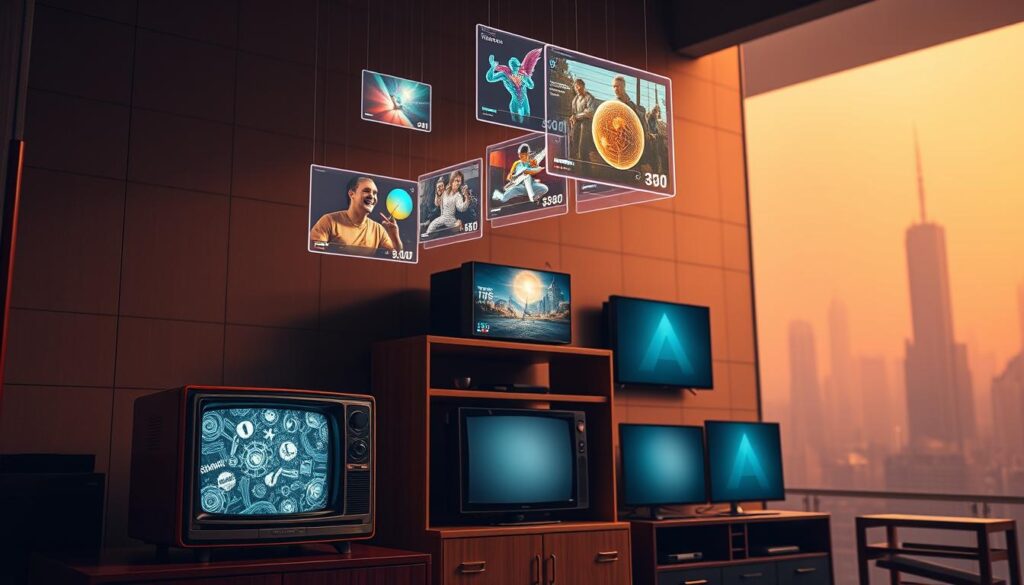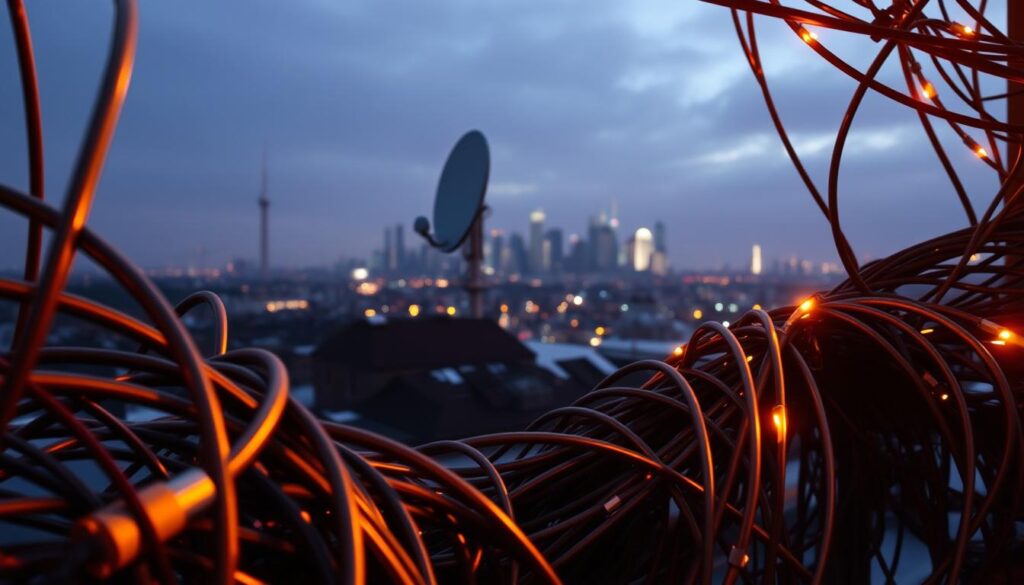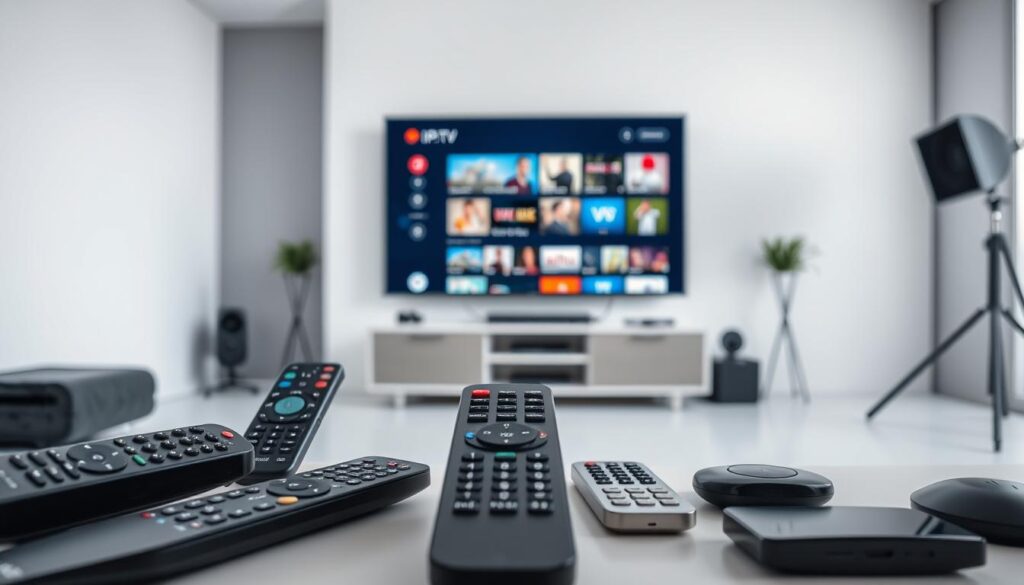By 2025, over 60% of U.S. households are projected to switch from traditional TV services to internet-based alternatives. This seismic shift reflects viewers’ growing demand for flexibility, affordability, and personalized content. While cable television once dominated living rooms, internet protocol television (IPTV) is rapidly reshaping how we consume media.
Modern audiences no longer want rigid broadcast schedules or bulky equipment. Instead, they crave on-demand access across devices—whether binge-watching on a tablet or streaming live sports in 4K. The battle between these two services isn’t just about channels; it’s a clash of old and new technologies fighting to meet evolving expectations.
This article breaks down costs, content libraries, and technical requirements to help you choose wisely. We’ll also explore how geographic availability and internet reliability impact your viewing experience. Spoiler: One option lets you test-drive premium streaming for free—no contracts required.
Key Takeaways
- Internet-based TV services are expected to dominate 60% of U.S. households by 2025
- On-demand access and multi-device streaming drive consumer preference shifts
- Cost comparisons must include hidden fees like equipment rentals and installation
- Reliable high-speed internet is crucial for optimal IPTV performance
- Traditional cable still leads in areas with poor broadband infrastructure
- Free trials offer risk-free ways to test next-gen television services
Ready to experience the future? Claim your free IPTV trial or chat via WhatsApp for instant support. Your perfect entertainment setup awaits.
Understanding the Evolution of Television
The way we watch TV has transformed dramatically since the days of rabbit-ear antennas. Two distinct technologies now dominate home entertainment: one rooted in decades-old infrastructure, the other riding the internet revolution.

The Legacy of Cable TV
For over 40 years, coaxial cables delivered crisp signals through broadcast networks. This system used dedicated lines to bring scheduled shows into living rooms. Families planned evenings around prime-time lineups, flipping channels with clunky remotes.
Traditional cable’s strength lay in reliability. Weather rarely disrupted signals, and channel surfing became a cultural staple. However, this required:
| Feature | Cable TV | Modern Alternative |
|---|---|---|
| Signal Type | Analog/Digital Broadcast | Internet Data Packets |
| Equipment | Set-top Box | Wi-Fi Router |
| Content Access | Scheduled Programming | On-Demand Library |
The Emergence of New Viewing Methods
Modern solutions like premium streaming services bypass physical cables entirely. Instead of broadcast towers, content travels through home internet connections. This shift enables pause/rewind live TV and watch parties across time zones.
Viewers now expect personalized recommendations and 4K streaming on mobile devices. While traditional cable adapts with apps, its infrastructure can’t match internet-based flexibility. The future favors systems that merge live TV with on-demand libraries seamlessly.
Technical Differences: How Cable TV and IPTV Operate
At their core, these services use entirely distinct delivery systems. One relies on decades-old physical infrastructure, while the other harnesses modern data networks to redefine home entertainment.

Cable TV Architecture and Signal Transmission
Traditional providers use a centralized broadcast model. Content starts at a headend facility, traveling through coaxial cables to neighborhood nodes. Amplifiers boost the signal as it splits across multiple homes.
Each channel occupies specific frequencies within the cable. Your set-top box decodes these signals, converting them into viewable content. This system requires:
- Physical wiring to every household
- Dedicated hardware for signal interpretation
- Geographic proximity to provider infrastructure
Digital Streaming and Internet Protocol in IPTV
Modern services transform entertainment into data packets. Using internet protocol technology, content streams through your existing Wi-Fi or Ethernet connection. This approach eliminates coaxial dependencies.
When you select a show, your device contacts the provider’s server directly. The system then transmits only the requested content, reducing bandwidth waste. Key advantages include:
- Compatibility with smartphones, tablets, and smart TVs
- Real-time interaction (pause/rewind live TV)
- Personalized recommendations via cloud analytics
For those weighing options, our comparison guide breaks down technical specifics in greater detail. The choice ultimately depends on your internet reliability and desired features.
iptv vs cable: Comparing Content, Channels, and Customization
Viewers now prioritize tailored experiences over predetermined packages. The modern entertainment landscape rewards services that adapt to individual preferences rather than forcing standardized bundles.

Breaking Free From Fixed Packages
Traditional providers group channels into tiers dictated by corporate deals. A sports fan might pay for 15 cooking networks just to access ESPN. This “all-or-nothing” approach wastes money on unwanted content.
Next-gen solutions flip this model. Users select specific genres or individual stations through intuitive menus. Want documentaries without reality TV? That’s now possible with granular selection tools.
Your Schedule, Your Screen
Cloud-based libraries let viewers watch shows whenever they choose. Missed last night’s game? Full replays wait in your personalized hub. Key upgrades include:
- Archive access to entire seasons
- Multi-profile setups for family members
- AI-curated recommendations based on viewing history
Sports enthusiasts gain instant replays and alternate camera angles during live events. Binge-watchers enjoy ad-free marathons across devices. This flexibility extends beyond streaming—many services offer free trials to test advanced features risk-free.
Cost Considerations: Subscription, Equipment, and Value
Monthly entertainment budgets face new scrutiny as viewers balance channel access against hidden fees. Traditional services and modern platforms take opposing approaches to pricing structures.
Breaking Down Recurring Charges
Standard cable packages often hide costs behind promotional rates. A $69/month plan might balloon to $120 after adding:
- Set-top box rentals ($15/mo)
- Regional sports fees ($8.50/mo)
- Broadcast TV surcharges ($22/mo)
Stream-first providers use transparent pricing. Base plans start at $40/month with no equipment fees. Most let you add only the channels you want through modular packages.
Initial Investment Realities
| Expense Type | Traditional Service | Internet-Based Option |
|---|---|---|
| Installation | $50-$200 | $0 |
| Equipment | $10/mo rental | Owned devices |
| Contract Penalty | Up to $480 | $0 |
Cable requires professional installers and binding agreements. Modern alternatives work through apps on existing gadgets. This eliminates upfront costs while offering trial periods to test services risk-free.
Over three years, the average household saves $1,836 choosing flexible subscriptions. As one industry analyst notes: “Viewers now demand financial control as much as content choice.”
Reliability and Accessibility in 2025
Viewers demand consistent performance whether they’re streaming a championship game or binge-watching dramas. Two critical factors determine service reliability: infrastructure resilience and adaptive technology.
Network Strength, Signal Quality, and Weather Impacts
Traditional broadcast systems use copper cables that corrode over time. A 2024 FCC report found 23% of cable subscribers experience signal degradation during storms. Heavy rainfall can weaken connections, while frozen amplifiers disrupt entire neighborhoods.
Modern viewing solutions bypass these issues through cloud-based networks. Data packets route around congestion automatically, maintaining picture clarity. As one engineer explains: “Fiber-optic internet handles weather better than century-old coaxial tech.”
Geographic Limitations vs. Internet Connectivity
Rural areas face unique challenges. Running cables through mountainous terrain costs providers $30,000 per mile—a barrier limiting access. Satellite alternatives often suffer latency issues during peak hours.
High-speed broadband changes this equation. With 85% of U.S. homes now having internet access, services like those detailed here deliver HD content anywhere. Urban users benefit from 5G backups when Wi-Fi falters.
Key differences emerge in performance metrics:
- Peak-hour stability: Cable maintains fixed bandwidth
- Mobile access: Internet-based services work on 4G/5G
- Quality adaptation: Streaming adjusts to connection speeds
Flexibility, Interactivity, and Modern Viewing Experience
Modern viewers demand more than just content—they want complete control over their entertainment experience. Advanced platforms now blend seamless access with smart home integration, redefining what it means to watch your favorite shows.
Watch Anywhere, Anytime
Streaming services work across smartphones, tablets, and smart TVs. Start a movie on your laptop during lunch, then finish it on your living room screen. This multi-device flexibility eliminates location barriers while syncing progress automatically.
Smart Home Synergy
Voice commands through Alexa or Google Home let you search content hands-free. Lights dim when movies play, and thermostats adjust based on viewing habits. These features create a unified ecosystem that traditional setups can’t match.
Tailored Entertainment
AI learns your preferences to suggest hidden gems in your favorite genres. Create separate profiles for kids’ cartoons or late-night documentaries. Pause live sports to grab snacks without missing crucial plays—rewind works even during broadcasts.
Experience these premium features risk-free with our free trial. Need help setting up? Message us on WhatsApp for instant support. Your perfect viewing journey starts now.
FAQ
What’s the primary difference between traditional broadcast and internet-based television services?
Traditional broadcast relies on satellite or coaxial cables to deliver scheduled programming, while internet-based services use your home network to stream content. The latter offers on-demand libraries, personalized recommendations, and multi-device access without requiring physical infrastructure.
Do broadcast networks like ABC or NBC still dominate channel lineups in 2025?
Yes, many providers include local broadcast networks in their packages. However, internet-based platforms often supplement these with niche streaming channels, international content, and exclusive shows unavailable through conventional bundles.
Are subscription fees for digital streaming more affordable than legacy TV packages?
Typically, yes. Internet protocol services often have lower base prices due to reduced infrastructure costs. However, premium add-ons or ultra-HD upgrades can increase monthly bills. Always compare hidden fees like equipment rentals or data caps.
How does weather affect signal quality for these services?
Satellite-dependent systems may struggle during storms, while internet-based streaming relies on network stability. Fiber-optic connections minimize weather-related disruptions, but power outages can impact both options.
Is a set-top box mandatory for accessing modern television services?
Legacy providers usually require proprietary hardware for decryption. In contrast, many internet-based platforms work via apps on smart TVs, gaming consoles, or mobile devices, though some offer optional boxes for enhanced features.
What internet speed is needed for buffer-free 4K streaming?
Speeds of 25 Mbps or higher are recommended for ultra-HD content. Households with multiple devices should consider 50+ Mbps plans to maintain quality during peak usage times.
Can I customize channel bundles with digital streaming providers?
Absolutely. Most platforms let you choose themed packs (sports, movies) or build à la carte lineups. This flexibility contrasts with fixed bundles from traditional broadcasters, though premium networks may cost extra.
Are there geographic restrictions for accessing content through internet-based TV?
Licensing agreements sometimes limit regional availability. However, VPN-compatible services allow broader access compared to location-bound cable infrastructure.
How do interactive features enhance the viewing experience?
Advanced platforms integrate watch parties, real-time polls, and AI-driven recommendations. Voice-controlled navigation via Alexa or Google Assistant also simplifies content discovery across devices.
Will 5G networks impact television service reliability in 2025?
Expanding 5G coverage reduces latency, enabling smoother mobile streaming and supporting bandwidth-heavy formats like VR content. This strengthens internet-based TV’s edge over terrestrial options in urban areas.



